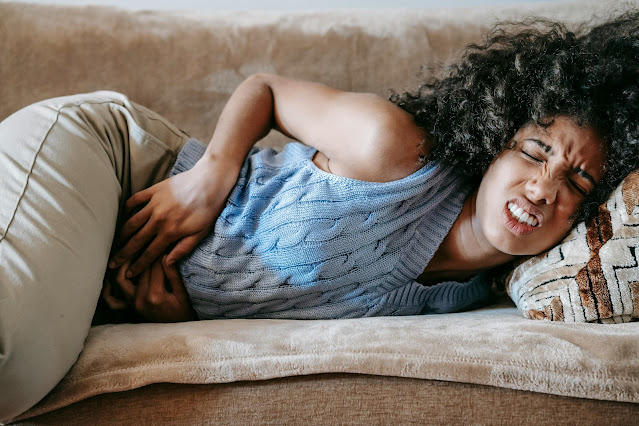Menstruation occurs when the uterus sheds it lining. This occurs throughout a woman's reproductive life. The shedding of the lining of the uterus is done to prepare itself(endometrium) for the nourishment of the fetus.
 |
| Sora Shimazaki | pexel |
Why menstruation is important throughout a woman reproductive life, it can also be painful due to some factors.
Menstrual pain , medically termed dysmenorrhea. It is the aching cramps, throbbing or discomfort you feel in your lower belly before or after your menstrual period. Depending on the type, it can be mild or severe , but with age it usually become less painful and may stop entirely.
However, certain menstrual pain may be as a result of some underlying factors, such as uterine fibroids, endometriosis etc.
What are types of menstrual pain known?
Primary dysmenorrhea: This type of menstrual pain is also called common menstrual cramps. The pain may be mild or severe, and can also last 12 to 72 hours. The pain usually begins one or two days before your menstrual period, or when the bleeding starts.
Primary dysmenorrhea may become less painful as get older and may even stop entirely if you have a baby.
Secondary dysmenorrhea: t's a menstrual pain that occurs as a result of disease, disorder, or infection in your reproductive organs, and certain underlying medical conditions such as endometriosis, pelvic inflammatory disease, etc.
What are the causes of menstrual pain?
Identifying the cause(s) of menstrual pain is not always possible, but certain people may be at high risk of having it,
These risks includes;
- Reaching puberty t an early age, especially before age 11
- Having irregular menstrual periods
- Family history of menstrual pain.
Menstrual pain literally occurs when the uterus tighten up as a result of a chemical called prostaglandin. The uterus been a muscle, when contracting occurs more than the normal rate, it can press against the blood vessels, cutting off the supply of oxygen to muscle tissues, this can make you feel pain.
Menstrual pain can also occur as a result of reproductive organ problems, this includes;
- Endometriosis
- Adenomyosis
- Pelvic inflammatory disease
- Fibroid
Endometriosis: This is a condition whereby the tissue lining the uterus is found outside the uterus. As a result of it bleeding during menstrual period, it can lead to pain and swelling.
Pelvic inflammatory disease(PID):This can happen in the uterus and can also spread to other parts of the reproductive organ. This infection is caused by bacteria, it can cause pain during sex or in the stomach
Adenomyosis: This condition can make the uterus increase in size than normal, causing pain and abnormal bleeding during your menstrual period.
Fibroid: This is a condition in which tumor grows inside, outside, or in the uterus. As the uterus contract, this tumor can press hard on the blood vessels or tissues which can cause you to feel pain.
When should you see a doctor?
The treatment of menstrual pain depends on it severity and it causes. There are certain medications that are used to counter menstrual pain.
These includes;
In severe cases , if treatment failed, surgery can be done. This can be done to remove fibroid if any), in or outside of the uterus. In dangerous cases the uterus can be removed to prevent death.
If your uterus is removed you will no longer be able to give birth.
Note: menstruation is normal. If you are having severe pain during your menstrual period, consult a doctor as quick as possible.
Your Health is your wealth...
